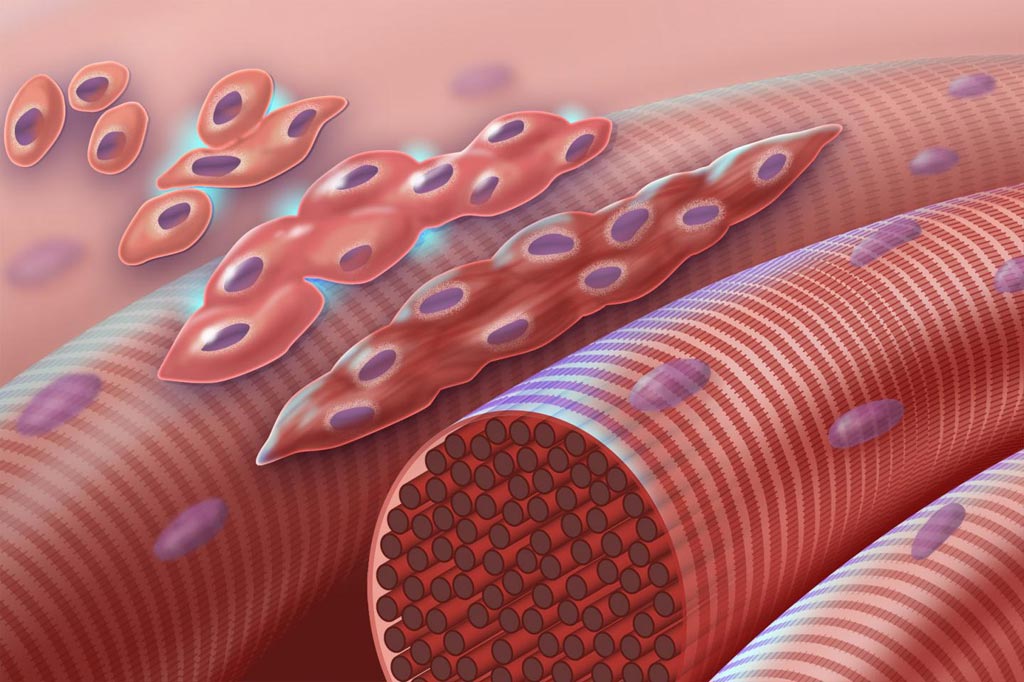Genetic Mutations Causing CFZ Syndrome Identified
By LabMedica International staff writers
Posted on 18 Jul 2017
Researchers have identified gene mutations that cause, via a defect in myoblasts fusion, the rare inherited muscle disorder Carey-Fineman-Ziter Syndrome (CFZS), and have thereby also uncovered a mechanism underlying muscle development.Posted on 18 Jul 2017
CFZS is a congenital myopathy characterized by facial weakness, a small or retracted chin, a cleft palate, and scoliosis, among other symptoms. The researchers, a team of collaborators from several institutions, found that functional mutations in the gene for the protein myomaker (MYMK) cause CFZS. MYMK is necessary for the fusion of myoblast cells into myotubes (muscle fibers) during embryonic development and for regeneration of muscle cells after injury.

Image: Myoblast fusion. This graphic depicts normal myoblast (early muscle cells with a single nucleus) fusing together to form myocytes (multinucleated muscle cells) during myogenesis. In Carey-Fineman-Ziter syndrome this cascade is disrupted because of a defect in the membrane protein myomaker (MYMK) required for cell-cell fusion (Photo courtesy of Darryl Leja, NHGRI).
"Advances in genomics technology and the power of team science have enabled us to identify the cause of this very rare disease 35 years after it was first described by Dr. John Carey and colleagues from the University of Utah," said study coauthor Francis S. Collins, MD, PhD, National Institutes of Health (NIH) director.
People affected with CFZS have sometimes been misdiagnosed with Moebius syndrome, another very rare disorder characterized by facial paralysis. "This discovery will improve physicians' ability to diagnose this disease and offer families accurate genetic counseling and treatment," said study co-leader Irini Manoli, MD, PhD, physician scientist and staff clinician at NIH’s National Human Genome Research Institute (NHGRI; Bethesda, MD, USA).
"In addition," said Dr. Manoli, "this rare genetic syndrome provides novel insights into the effects of muscle development on craniofacial and skeletal bone formation" – opening a new path of exploration and for development of muscle regeneration tools.
The study goal was to learn more about the genetics and clinical characteristics of Moebius syndrome and other congenital facial weakness disorders. The Moebius Syndrome Research Consortium brought 63 patients and their families for detailed multi-system evaluations, including brain and muscle imaging studies and muscle biopsies. The researchers collaborated through the Opportunities for Collaborative Research at the NIH Clinical Center, a new funding mechanism that encourages intramural and extramural researchers to work together.
The researchers performed detailed phenotyping, and employed exome sequencing of blood DNA in affected siblings from 3 unrelated families, as well as a muscle biopsy in one of the affected individuals. To identify genomic mutations associated with CFZS, three laboratories -led separately by Elizabeth Engle, MD, of Boston Children's Hospital (USA), Stephen Robertson, MD, of University of Otago (New Zealand), and John Carey, MD, at University of Utah (USA)- analyzed exome sequence data from each of the 3 families.
Among the genes harboring mutations identified in each family, only the gene for MYMK was common to all three. A MYMK knockout mouse model displayed a complete lack of muscle development, leading to early death of the newborn mice, making the mymk gene a good candidate for further studies. Using CRISPR-Cas9 technology, a team led by first author Silvio Alessandro Di Gioia, PhD, and Dr. Engle generated zebrafish with mutated mymk. Affected mutant zebrafish were smaller and had abnormal muscle development and jaw deformities, resembling the patient phenotype. They then performed functional studies on the severity of each of the genomic mutations.
They were able to correct affected zebrafish muscles by injecting the normal human MYMK protein into the mutant fish, a success that lends hope for restoring MYMK function in muscles as a treatment for CFZS and for reducing potentially progressive features of this disorder.
Only 8 people worldwide have been diagnosed with CFZS with MYMK mutations. Now mymk can be added to the diagnostic gene panels for congenital myopathies, which will improve diagnosis and add to understanding of the spectrum of disease severity and outcome.
The study, by Di Gioia SA et al, was published July 6, 2017, in the journal Nature Communications.
Related Links:
National Human Genome Research Institute














